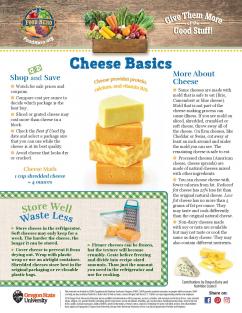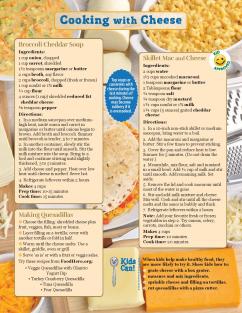Cheese Basics
Cheese provides protein, calcium and vitamin B12.
Shop and Save
- Watch for sale prices and coupons.
- Compare cost per ounce to decide which package is the best buy.
- Sliced or grated cheese may cost more than cheese in a block.
- Check the Best if Used By date and select a package size that you can use while the cheese is at its best quality.
- Avoid cheese that looks dry or cracked
Cheese Math
1 cup shredded cheese = 4 ounces
Store Well Waste Less
- Store cheese in the refrigerator. Soft cheeses may only keep for a week. The harder the cheese, the longer it can be stored.
- Cover cheese to prevent it from drying out. Wrap with plastic wrap or use an airtight container. Shredded cheeses store best in the original packaging or re-closable plastic bags.
- Firmer cheeses can be frozen, but the texture will become crumbly. Grate before freezing and divide into recipe-sized amounts. Thaw just the amount you need in the refrigerator and use for cooking.
More About Cheese
- Some cheeses are made with mold that is safe to eat (Brie, Camembert or blue cheese). Mold that is not part of the cheese-making process can cause illness. If you see mold on sliced, shredded, crumbled or soft cheese, throw away all of the cheese. On firm cheeses, like Cheddar or Swiss, cut away at least an inch around and under the mold you can see. The remaining cheese is safe to eat.
- Processed cheeses (American cheese, cheese spreads) are made of natural cheeses mixed with other ingredients.
- You can choose cheese with fewer calories from fat. Reduced fat cheese has 25% less fat than the original natural cheese. Low fat cheese has no more than 3 grams of fat per ounce. They may taste and cook differently than the original natural cheese.
- Non-dairy cheeses made with soy or nuts are available but may not taste or cook the same as dairy cheese. They may also contain different nutrients.
Contributions by Oregon Dairy and Nutrition Council
Cooking with Cheese
Recipes
Broccoli Cheddar Soup
Skillet Mac and Cheese
Making Quesadillas
- Choose the filling: shredded cheese plus fruit, veggies, fish, meat or beans.
- Layer filling on a tortilla; cover with another tortilla or fold in half. Warm until the cheese melts. Use a skillet, griddle, oven or grill.
- Serve 'as is' or with a fruit or veggie salsa.
Try these recipes from FoodHero.org:
- Veggie Quesadillas with Cilantro Yogurt Dip
- Turkey Cranberry Quesadilla
- Tuna Quesadilla
- Pear Quesadilla
Top soups or casseroles with cheese during the last minutes of cooking. Cheese may become rubbery if it is overcooked.
Kids Can!
When kids help make healthy food, they are more likely to try it. Show kids how to:
- grate cheese with a box grater.
- measure and mix ingredients.
- sprinkle cheese and filling on tortillas.
- cut quesadillas with a pizza cutter.




